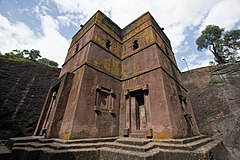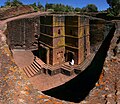Kościoły skalne w Lalibeli
| Obiekt z listy światowego dziedzictwa UNESCO | |
 Kościół świętego Jerzego | |
| Państwo | |
|---|---|
| Typ | kulturowy |
| Spełniane kryterium | I, II, III |
| Numer ref. | |
| Region[b] | Afryka |
| Historia wpisania na listę | |
| Wpisanie na listę | 1978 |
Kościoły skalne w Lalibeli – grupa jedenastu cennych historycznie i ciekawych architektonicznie skalnych kościołów w Lalibeli, w północnej Etiopii, wykutych w litej skale pod koniec XII i na początku XIII wieku. Kościoły zostały ozdobione reliefami. Pierwszym Europejczykiem, który odwiedził kościoły był portugalski jezuita Francisco Álvares w 1520 roku.
Opis
Wysokość wielu kościołów przewyższa 10 m, a niektóre świątynie połączone są tunelami. Architektura i zdobnictwo świątyń zdradza wpływy greckie, egipskie a nawet islamskie.
Kościoły formują dwie grupy – po północnej i południowej stronie strumyka Jordan.
Jeden z kościołów – kościół Świętego Jerzego – został wykuty 27 m od innych, ale połączony z nimi poprzez system rowów.
Cztery kościoły – Biete Medhani Alem, Biete Mariam, Biete Amanuel i Świętego Jerzego – to wolnostojące bloki skalne, wyraźnie oddzielone od otaczającej ich skały – kościoły monolityczne. Pozostałe świątynie nie są w pełni monolityczne, ponieważ nie są w pełni oddzielone od otaczającej ich skały – przynajmniej jedną ze ścian lub dach tworzą otaczające je skały.
W 1978 roku wykute w skale kościoły w Lalibeli wpisano na listę światowego dziedzictwa kulturalnego UNESCO.
Spis kościołów
Po północnej stronie znajdują się:
- Biete Medhani Alem (wolne tłum. kościół Zbawcy Świata) – pięcionawowa świątynia, najprawdopodobniej największy wykuty w skale kościół na świecie
- Biete Mariam (wolne tłum. kościół Maryi) – z malowidłami Gwiazdy Dawida i scen z życia Jezusa, m.in. ucieczki do Egiptu
- Biete Maskal (wolne tłum. kościół Krzyża)
- Biete Denagel (wolne tłum. kościół Dziewic)
- Biete Golgotha Mikael (wolne tłum. kościół Golgoty Michała) – kościół Golgoty dzieli z kościołem Michała ten sam dach; w kościele Golgoty znajduje się Kaplica Trójcy Świętej – najświętsze miejsce w Lalibeli. Tradycja utrzymuje, że spoczywa tu Lalibela.
Po stronie południowej znajdują się:
- Biete Amanuel (wolne tłum. kościół Emmanuela)
- Biete Qeddus Mercoreus (wolne tłum. kościół św. Marka)
- Biete Abba Libanos (wolne tłum. kościół Abby Libanosa)
- Biete Gabriel Raphael (wolne tłum. kościół Gabriela Rafaela)
- Biete Lehem (wolne tłum. kościół św. chleba).
Galeria
Media użyte na tej stronie
Autor: A. Davey from Where I Live Now: Pacific Northwest, Licencja: CC BY 2.0
You'll have to use your imagination to visualize what this 13th century church facade would look like without the scaffolding.
With enough time, I could probably PhotoShop the scaffolding out of existence, but I'm afraid the exercise would leave me very cross, perhaps slightly mad, and old beyond my years.Autor: Katie Hunt from St Albans, UK, Licencja: CC BY 2.0
Bet Golgotha
Autor: BluesyPete, Licencja: CC BY-SA 3.0
Church of St. Mercurios is a partial grotto church in the eastern part of the complex, with 8 roughly hewn pillars in its façade.
Autor: Jialiang Gao www.peace-on-earth.org, Licencja: CC-BY-SA-3.0
L'Eglise Beta Giorgis (Saint George), une des 11 églises monolithiques de Lalibela classées au patrimoine mondial de l'UNESCO http://whc.unesco.org/en/list/18
Autor: A. Davey from Where I Live Now: Pacific Northwest, Licencja: CC BY 2.0
The signs of age only contribute to this 13th-century church's simple appeal.
If you'll compare the church's right and left corners, you'll see the left side is solid rock, while the right appears to be built of masonry blocks of the same material as the rest of the church.
This difference suggests the right side was rebuilt with masonry blocks after it collapsed. Another possibility is the stone in that part of the rock face wasn't structurally sound when the church was built, so masonry blocks have always formed the church's right corner.
It is challenging to photograph a building such as this, with its strong (almost) vertical and (almost) horizontal lines. The lens I used tends to distort such images so what you see through the viewfinder is most definitely not what you get when you view the photograph.
I corrected the lens distortion as best I could with Photoshop CS3.
If the columns, windows, doors and roof line aren't plumb, it's probably due to the toll time and the elements have taken on the building. I think it adds to the charm.
=====================================================
In his Bradt Guide Ethiopia (November 2005, 4th Ed.), Phillip Briggs writes:
"According to the legends, Bet Abba Libanos was built overnight by Lalibela's wife Meskel Kebre, assisted by a group of angels."
"The church has been built around [sic] a cave in a vertical face, and although the roof is still connected to the original rock, the sides and back are separated from the rock by narrow tunnels."
"The pink-tinged façade, which once again shows strong Axumite influences in its arched and cruciform windows, lies under an overhang in a way that is reminiscent of some churches in Tigrai."Autor: Katie Hunt from St Albans, UK, Licencja: CC BY 2.0
Bet Gabriel-Rufael
Autor: BluesyPete, Licencja: CC BY-SA 3.0
This structure is linked with Beta Abba Libanos.
Autor: Bernard Gagnon, Licencja: CC BY-SA 3.0
Bete Giyorgis (Church of St. George), Lalibela, Ethiopia
Flag of Ethiopia
Flag of the United Nations Educational, Scientific and Cultural Organization (UNESCO)


























